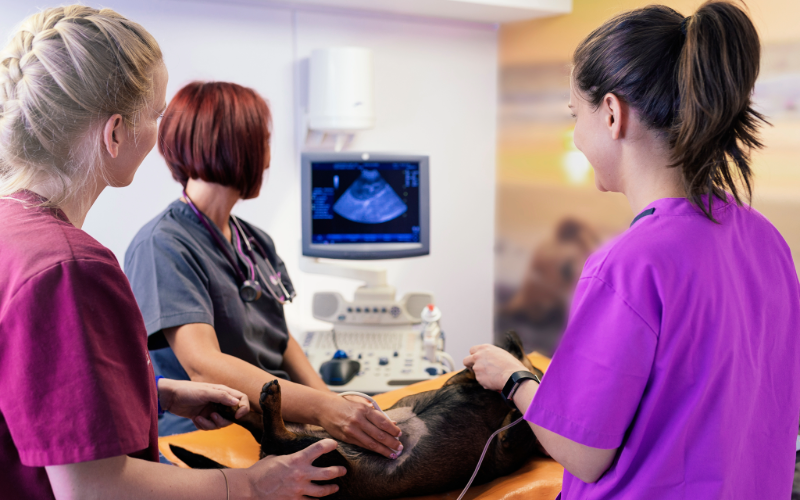Ultrasound and Endoscopy: What They Are and How They Are Used

Ultrasound
What is it?
A veterinary ultrasound is performed using a special tool that helps veterinarians look inside animals to see their organs and tissues. It uses sound waves to create images of what is happening inside a pet's body - just like sonograms in people, especially when a woman is pregnant.
Here's how it works:
The veterinarian usually clips a little fur away in an area, applies a gel to the animal's skin and then moves a small wand called a transducer over the area being examined. The transducer sends out sound waves that bounce off the organs and tissues inside the pet.
These sound waves then bounce back to the transducer, which turns them into images that show the veterinarian the inside of the animal's body on a screen. This allows the doctor to see things like the pet's heart, liver, kidneys, intestines and even unborn puppies or kittens in a pregnant animal.
Veterinary ultrasound is painless, safe, and non-invasive, meaning it doesn't require any cuts or surgery. However, since the pet doesn’t always understand what we are trying to do, a little medicine to help calm them is usually helpful. The whole procedure usually takes between 15-30 minutes. It helps veterinarians diagnose health problems and monitor their progress during treatment.
Why would my pet need an ultrasound?
Most abdominal ultrasounds are recommended by the family vet when the pet has been vomiting, seems painful in the belly, is not eating well, has lost weight, or is having chronic diarrhea. Chronic urinary tract infections (UTIs) and abnormal blood test results (like abnormal kidney or liver values) are other common reasons for recommending an abdominal ultrasound.
What happens after an ultrasound?
The family veterinarian will share the findings to help owners make decisions about more testing or treatment options. Sometimes another veterinarian, a board-certified specialist, is brought into the discussion to provide guidance or more advanced options.
Ultrasound is just a test, and it has its limitations. It’s helpful to think of it as one step in the process of figuring out what is wrong with the pet. It can be costly, and may not be easily available in some areas. Ultrasound cannot “fix” the problem, rather it is a tool that helps guide the next steps, be it a treatment plan, additional testing, or procedures such as surgery or endoscopy (tube with a camera that allows a veterinarian to see inside the body). But keep in mind - it is a very helpful test and is much more available these days so it is very common to use this type of tool in our pets.
Endoscopy
What is it?
A veterinary endoscopy is a procedure that helps veterinarians see inside animals without needing to perform surgery. It uses a long, thin tube called an endoscope. It has a tiny camera and light at one end, with a lens at the other that allows veterinarians to see inside the body. This type of test is usually performed by a board-certified internal medicine specialist.
Here's how it works:
The pet is placed under general anesthesia or is “asleep” during the whole procedure. The veterinarian gently inserts the endoscope into the animal's body through a natural opening, like the mouth or anus. The endoscope sends images to a screen, allowing the veterinarian to see inside, in this example, the intestinal tract.
Many times endoscopy is recommended because the pet has signs of vomiting, diarrhea, weight loss, or hasn’t been eating well. In some cases, it is used in pets that have an abnormal object stuck in the stomach. Pets eat all kinds of things they shouldn’t!
The endoscope has a channel that allows the veterinarian to pass small cup-like instruments that can take tissue samples, called biopsies, or long graspers that grip onto things to pull them back out, avoiding surgery.
Why would my pet need an endoscopy?
Endoscopy can be used to look inside different parts of the animal's body, such as the stomach, intestines, inside the nose or lungs, and in the urinary bladder. It helps veterinarians diagnose health problems like digestive conditions, tumors, infections, or foreign objects stuck in the animal's body.
Endoscopy is a safe and minimally invasive procedure, meaning it causes minimal discomfort to the animal and doesn't require any major cuts or incisions. It helps the veterinarian investigate what's happening inside the pet without the need for surgery.
What happens after an endoscopy?
The pet gently wakes up and in most cases, goes home the same day, just like a human patient would - it is considered an “outpatient” procedure. If biopsy samples were collected, the lab will analyze them and send a report to the veterinarian. Based upon the results, the veterinarian will develop a treatment plan. This may involve medications, dietary changes, or additional testing.
View the author's profile
Articles by Specialty
- Cardiology (18)
- Large Animal Internal Medicine (23)
- Neurology (16)
- Oncology (20)
- Small Animal Internal Medicine (25)
Articles by Animal
- Cats (35)
- Dogs (47)
- Farm Animals (5)
- Horses (12)
